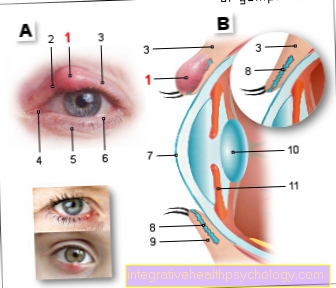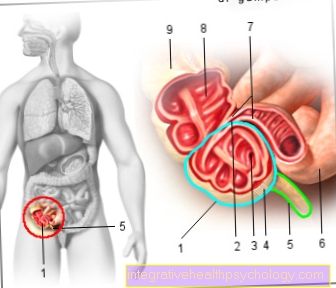Symptoms of Diabetes Mellitus
introduction
There are a number of symptoms that can indicate diabetes mellitus.
Symptoms
There can be several, for one Diabetes disease unspecific symptoms occur, such as
- persistent fatigue
- languor
- Exhaustion
- Reduction in performance
- Susceptibility to infection
- poorly healing wound
- Frequent urination

Symptoms of diabetes due to high blood sugar levels include being very thirsty, losing weight, and going to the toilet frequently to urinate. In the case of diabetes, the skin can be itchy, fungal infections, reddening of the face and brownish spots on both lower legs.
Due to diabetes, nerve disorders and thus diseases from the field of neurology occur more frequently.
Read more about it: Diabetic neuropathy
Men can experience symptoms such as erectile dysfunction and women may not have their monthly menstrual period.
The diabetic involvement of the lens of the eye can lead to impaired vision.
While in type 1 diabetics the so-called "acute hyperglycemic symptoms"Such as weight loss, increased thirst and frequent urination, are chronic sequelae of diabetes, e.g. Occlusions of the leg arteries (PAD = peripheral arterial occlusive disease), cause for complaints in type 2 diabetes.
Read more on the topic: How do I recognize diabetes?
diagnosis

Diabetes can be identified from a typical medical history (anamnese) diagnose: The diabetic complains of increased thirst, frequent urination, weight loss and tiredness.
The doctor continues to look for symptoms of a metabolic imbalance and checks whether there is already any late-stage diabetic damage. Both type 1 and type 2 diabetes have a genetic component, so information about other cases of illness in the family can point the way for the diagnosis of "diabetes".
To determine the disease diabetes, it is necessary to determine the blood sugar level. The diagnosis of diabetes is confirmed when
- in a patient with symptoms, the casual blood glucose level, i. without the patient having observed a fasting phase, is greater than or equal to 200 mg / dl (milligrams per deciliter).
- the glucose level in the blood of the fasted patient is above 126 mg / dl in two independent measurements. Fasting means that there was no food intake for 8 hours prior to the examination.
For comparison: in healthy people, the fasted blood sugar level is normally below 110 mg / dl. - As part of an oral glucose tolerance test (oGTT), the blood sugar level is still above 200 mg / dl 2 hours after the glucose administration.
The oral glucose tolerance test works as follows: The patient eats a high-carbohydrate diet for 3 days (at least 150g per day). After 10-16 hours of abstinence from food and alcohol, the patient drinks 75g of glucose within 5 minutes in the morning while sitting or lying down and remains under medical supervision. The blood sugar level is determined on an empty stomach and 2 hours after drinking the glucose solution. At values above 140 mg / dl and below 200 mg / dl, the patient has impaired glucose tolerance, values above 200 mg / dl indicate diabetes mellitus.
Further important information about this test can be found at: Glucose Tolerance Test - What You Should Know!
The glucose in urine should also be determined. If glucose occurs repeatedly in the urine, diabetes mellitus is present with a few exceptions. This has the following reason: From a blood sugar level of 160-180 mg / dl, which is present in a diabetic because of the lack of insulin action, glucose is filtered from the kidneys into the urine. This value is called the “kidney threshold”, since from here on excess glucose is excreted through the kidneys. The filtration of the glucose causes water to be withdrawn from the body and the urine volume increases. The increased urine volume explains the typical symptoms of the patient:
- frequent urination and
- enormous thirst.
Read more about the topic here: frequent urination
Another diagnostic tool is that Ketone body determination in the urine. Ketone bodies are substances that contribute to Insulin deficiency to be produced. If their concentration in the urine is increased, this indicates an insulin deficiency and is a warning sign of a metabolic imbalance.
Further examinations can be carried out to determine comorbidities and diabetic consequential damage to other organs.
These include:
- the test of kidney function
- the determination of blood lipid levels and the Cholesterol
- a Fundus examination after dilating the pupil
- Vascular and neurological examinations (neurology)
- as well as assessing the function of the thyroid.
Every 3 years a fasting blood sugar test is performed as a screening test Diabetes mellitus carried out on people over 45 years of age. In the case of risk groups, this examination is carried out earlier, namely:
- if the patient has symptoms like high blood pressure, Obesity or suffer from a lipid metabolism disorder,
- if a first-degree relative has diabetes
- after the delivery of a child with a birth weight over 4500 g,
- having a history of gestational diabetes,
- if a patient has had a disturbed one in the past Glucose tolerance occured.
Medication
There are basically two different therapeutic approaches to drug therapy for diabetes mellitus.
-
On the one hand, one tries to support the residual function of the pancreas as much as possible with drugs that have to be taken so that the amount of insulin still produced is sufficient for daily needs.
-
On the other hand, if the pancreas is no longer able to produce enough insulin, you can inject the insulin from the outside in various forms.
You can find more information under: Medicines Diabetes mellitus
























.jpg)



